|
Don Berliner, who published
many articles and even books on scale model and full-sized aircraft, provided this
article on the SAAB J 21
fighter in a 1971 issue of American Aircraft Modeler magazine. Most people nowadays
associate the company name SAAB with high quality automobiles, although
Saab the car company
went defunct in 2012. From the World War II era through to today, they produce(d)
aircraft. Here is an excerpt from their current "About Us" webpage; "When
Saab was founded in 1937,
our primary aim was to provide military aircraft for Sweden. Today, we serve the
global market with world-leading products, services and solutions from military
defence to civil security. With operations on every continent, Saab continuously
develops, adapts and improves new technology to meet customers' changing needs."
The SAAB J 21 went through multiple design iterations as both a pusher-prop
and a jet fighter aircraft. Mr. Berliner gives a brief description of the aircraft's
history.
Swedish Saab
 Don Berliner Don Berliner
This unique fighter of the World War II period was manufactured in quantity
and operational in both piston- and jet-engined versions. Saw service over eight
years.
Just as some of the earliest control line models were actually converted free
flights, so some of the very early jets were little more than converted prop-driven
aircraft. And while they flew and provided considerable knowledge quickly and, no
doubt, inexpensively, they were hardly what anyone would call successful.
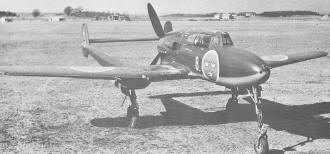
Increased visibility, streamlining, and concentrated firepower
were offered in this pusher design. Tricycle gear was early for 1943.
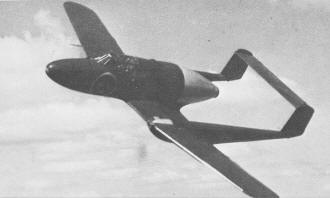
The J 21R jet version flew March 1947 - 64 were ordered.
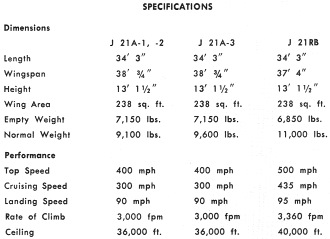
Saab J 21 Specifications
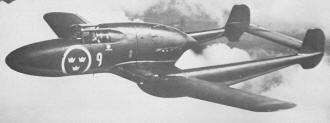
Because of pusher prop, pilot escape was a problem. The J 21
was fitted with one of the first production ejection seats. Top speed 400 mph.
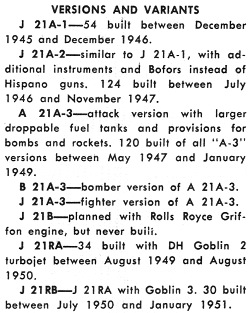
Saab J 21 Versions and Variants
The best example of this kind of quickie conversion, and the only one both produced
in quantity and used by operational squadrons, was the product of a firm now known
better for cars than airplanes: SAAB, of Linkoping, Sweden. The airplane which made
a bit of history was the SAAB J 21, not merely the first fighter to be produced
by this now famous company, but also the only combat aircraft having a pusher propeller
which was of any consequence and was built during World War II.
While the SAAB J 21 is hardly one of the important warplanes of the 1940's,
having been built in relatively small quantity and never having seen action, it
marked the beginning of a long line of highly impressive fighterplanes which SAAB
developed and which have enabled a country as small as Sweden to achieve a major
reputation for aviation technology.
SAAB began operations in April, 1937, by building foreign airplanes under license:
the Junkers Ju. 86K bomber from Germany, and the Douglas (Northrop) 8A attack bomber
and North American NA-16 (AT-6 prototype) trainer from the U.S. By 1938, the first
original design SAAB machine was being developed, and the first flight of the prototype
SAAB 17 single-engine dive bomber was made early in 1940. Several hundred of them
were produced, and the Swedish Air Force used them until 1947. The next in line
was the SAAB 18, an all-metal twin-engine bomber which bowed in 1944 as one of the
fastest aircraft of its type in the world.
Though it had a higher number, the interesting little J 21 fighter made
its first flight almost a year before the SAAB 18, in the summer of 1943. It went
into production late in 1945 and the first one was delivered to an operational unit
in the beginning of December of that year.
Because no native Swedish aircraft engine was in existence at that time, the
J 21 had to be powered by a license-built foreign engine. It was first planned
to use the Pratt & Whitney R-1830 Twin Wasp, an 800 hp radial which was being
built by Svenska Flygmotor as the STW C-3, but a need for considerably greater power
forced a switch to the German Daimler Benz DB 605B an air-cooled V-12 rated at 1475
hp for take-off, and similar to that used in the Messerschmitt Bf-109G. The Swedes
did considerable modification work on the engine, eventually developing it into
a type suitable for use in later models of the SAAB 18B as well as the J 21.
The basic twin-boom pusher layout was selected because of its advantages in increased
visibility, streamlining, and concentrated firepower. One of the most obvious disadvantages
was the risk to the pilot in the event he was forced to bailout, for he would go
directly into the path of the propeller. After considering such techniques as jettisoning
the propeller or even the entire engine, SAAB fitted the J 21 with one of the
earliest production ejection seats, development of which had begun back in 1939.
Another example of SAAB's far-sightedness was its use of tricycle landing gear,
still relatively rare when development work was begun on the J 21 in 1941.
Preliminary tests on the gear were made using a modified NA-16, with the same plane
then being used for pilot familiarization.
Armament on the J 21A was a standard grouping of a single 20 mm cannon and
two 13.2 mm (.52 cal.) machine guns in the nose, and a single 13.2 mm machine gun
in the leading edge of either wing, just outboard of the tail boom. The attack and
bombing versions of the later J 21A's could carry a single 550 lb., 1100 lb.
or 1300 lb. bomb slung under the fuselage pod, plus four 110-lb. bombs under the
wings. Either eight light rockets or two heavier ones could be mounted below the
wings.
As the end of the Second World War approached, it became evident to the engineers
at SAAB that the 400 mph top speed of their J 21 simply was not enough to challenge
the first-line fighters of any of the major powers, although none had seen fit to
attack her, and the Swedish Air Force must have been part of the reason. Looking
for an improved fighter, they first considered installing a 2000 hp Rolls Royce
Griffon engine like that in late-model Spitfires, and even a Griffon version with
contrarotating props, the combination used by the British in the experimental Seafang
32 which was capable of 475 mph at 21,000 feet. However, the estimated maximum speeds
of these two planned versions were only 416 mph for the J 21B and 435 mph for
the SAAB 27. But jets were coming.
The unusual design layout of the J 21 appeared to be easily adaptable to
jet power, and so the piston engine was removed and a Swedish-built, British-designed
deHavilland Goblin turbojet of some 3300 lbs. thrust was installed. The resulting
J 21R series was actually more new than old, with major changes being necessary
to the fuselage and tail, even though the overall dimensions were almost unchanged.
Initial design work began in 1946 and the first flight of the prototype J 21R
was made on March 10, 1947. The airplane worked, but obviously not as well as had
been hoped. The original production order for 120 was reduced to just 64, while
the Swedish Air Force bought deHavilland Vampires, a British jet very similar in
appearance and considerably superior in performance. The J 21R carried the
same fixed guns as its prop-driven predecessor, along with eight more 13.2 mm machine
guns in an odd-looking streamlined pod under the fuselage, and 10 rockets mounted
under the wing center section.
The operational life of the J 21A was almost eight years, from the first
delivery in December, 1945, until the last one was replaced by more modern aircraft
in 1953. The J 21R was in service for almost as long, from August, 1949, until
it, too, was superseded by better and faster jets in 1956. Not a single example
of the turbojet twin-boom machine is known to exist, but three of the earlier prop-driven
SAABs are still around. All are J 21A-3's, one of which is in the Stockholm
Museum of Technology, another in the Swedish Air Force Museum at Malmslatt, and
a third which was on display during the 1970 Scandinavian Aviation Exposition and
European EAA Fly-In at Angelhom.
Posted August 8, 2021
|



